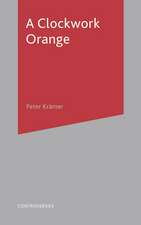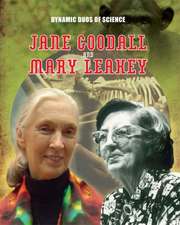Group Theory and the Interaction of Composite Nucleon Systems: Clustering Phenomena in Nuclei, cartea 2
Autor Peter Kramerde Limba Germană Paperback – 1980
Preț: 417.30 lei
Nou
Puncte Express: 626
Preț estimativ în valută:
79.85€ • 83.59$ • 66.07£
79.85€ • 83.59$ • 66.07£
Carte tipărită la comandă
Livrare economică 07-21 aprilie
Preluare comenzi: 021 569.72.76
Specificații
ISBN-13: 9783528084493
ISBN-10: 3528084499
Pagini: 236
Ilustrații: VIII, 224 S.
Dimensiuni: 152 x 229 x 17 mm
Greutate: 0.32 kg
Ediția:1981
Editura: Vieweg+Teubner Verlag
Colecția Vieweg+Teubner Verlag
Seria Clustering Phenomena in Nuclei
Locul publicării:Wiesbaden, Germany
ISBN-10: 3528084499
Pagini: 236
Ilustrații: VIII, 224 S.
Dimensiuni: 152 x 229 x 17 mm
Greutate: 0.32 kg
Ediția:1981
Editura: Vieweg+Teubner Verlag
Colecția Vieweg+Teubner Verlag
Seria Clustering Phenomena in Nuclei
Locul publicării:Wiesbaden, Germany
Public țintă
ResearchCuprins
1 Introduction.- 2 Permutational Structure of Nuclear States.- 2.1 Concepts and Motivation.- 2.2 The Symmetric Group S(n).- 2.3 Irreducible Representations of the Symmetric Group S(n).- 2.4 Construction of States of Orbital Symmetry, Young Operators.- 2.5 Computation of Irreducible Representations of the Symmetric Group.- 2.6 Spin, Isospin and the Supermultiplet Scheme.- 2.7 Matrix Elements in the Supermultiplet Scheme.- 2.8 Supermultiplet Expansion for States of Light Nuclei.- 2.9 Notes and References.- 3 Unitary Structure of Orbital States.- 3.1 Concepts and Motivation.- 3.2 The General Linear and the Unitary Group and Their Finite-Dimensional Representations.- 3.3 Wigner Coefficients of the Group GL(j, C).- 3.4 Computation of Irreducible Representations of GL(j, C) from Double Gelfand Polynomials.- 3.5 Computation of Irreducible Representations of GL(j,C) from Representations of the Symmetric Group S (n).- 3.6 Conjugation Relations of Irreducible Representations of GL (j, C).- 3.7 Fractional Parentage Coefficients and Their Computation.- 3.8 Bordered Decomposition of Irreducible Representations for the Group GL(j, C).- 3.9 Orbital Configurations of n Particles.- 3.10 Decomposition of Orbital Matrix Elements.- 3.11 Orbital Matrix Elements for the Configuration f = [4j].- 3.12 Notes and References.- 4 Geometric Transformations in Classical Phase Space and their Representation in Quantum Mechanics.- 4.1 Concepts and Motivation.- 4.2 Symplectic Geometry of Classical Phase Space.- 4.3 Basic Structure of Bargmann Space.- 4.4 Representation of Translations in Phase Space by Weyl Operators.- 4.5 Representation of Linear Canonical Transformations.- 4.6 Oscillator States of a Single Particle with Angular Momentum and Matrix Elements of Some Operators.- 4.7 Notes and References.- 5 Linear Canonical Transformations and Interacting n-particle Systems.- 5.1 Orthogonal Point Transformations in n-particle Systems and their Representations.- 5.2 General Linear Canonical Transformations for n Particles and State Dilatation.- 5.3 Interactions in n-body Systems and Complex Extension of Linear Canonical Transformations.- 5.4 Density Operators.- 5.5 Notes and References.- 6 Composite Nucleon Systems and their Interaction.- 6.1 Concepts and Motivation.- 6.2 Configurations of Composite Nucleon Systems.- 6.3 Projection Equations and Interaction of Composite Nucleon Systems.- 6.4 Phase Space Transformations for Configurations of Oscillator Shells and for Composite Nucleon Systems.- 6.5 Interpretation of Composite Particle Interaction in Terms of Single-Particle Configurations.- 6.6 Notes and References.- 7 Configurations of Simple Composite Nucleon Systems.- 7.1 Concepts and Motivation.- 7.2 Normalization Kernels.- 7.3 Interaction Kernels.- 7.4 Configurations of Three Simple Composite Nucleon Systems.- 7.5 Notes and References.- 8 Interaction of Composite Nucleon Systems with Internal Shell Structure.- 8.1 Concepts and Motivation.- 8.2 Single-Particle Bases and their Overlap Matrix.- 8.3 The Normalization Operator for Two-Center Configurations with a Closed Shell and a Simple Composite Particle Configuration.- 8.4 The Interaction Kernel for Two-Center Configurations with a Closed Shell and a Simple Composite Particle Configuration.- 8.5 Two Composite Particles with Closed-Shell Configurations.- 8.6 Two-Center Configurations with an Open Shell and a Simple Composite Particle Configuration.- 8.7 Notes and References.- 9 Internal Radius and Dilatation.- 9.1 Oscillator States of Different Frequencies.- 9.2 Dilatations in Different Coordinate Systems.- 9.3 Dilatations of Simple Composite Nucleón Systems.- 9.4 Notes and References.- 10 Configurations of Three Simple Composite Particles and the Structure of Nuclei with Mass Numbers A = 4–10.- 10.1 Concepts and Motivation.- 10.2 The Model Space.- 10.3 The Interaction.- 10.4 Convergence Properties of the Model Space.- 10.5 Comparison with Shell Model Results.- 10.6 Absolute Energies.- 10.7 The Oscillator Parameter b.- 10.8 Results on Nuclei with A = 4–10.- 10.9 Notes and References.- References for Sections 1–9.- References for Section 10.












